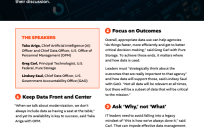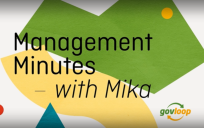Most of us are familiar with projects gone wrong, with indecision, delays and wasteful sidetracks when no one understood the project’s purpose. But up-front analysis can avoid those speedbumps, and it’s especially vital for data-driven projects, such as determining how an agency feeds residents experiencing food insecurity.

In other words, “you want to make sure that you’re solving the right problems, first and foremost,” said Ali Benson, Director of the Beeck Center for Social Impact and Innovation’s Data Labs at Georgetown University. To do that, define the challenge and then “ask yourself, ‘OK, what data do we have, what data do we need and what are potential solutions for it to solve this very specific problem,’” Benson said.
“You may be trying to boil the ocean,” she added, “when really you can take a targeted population that may be disproportionately experiencing challenges and you can focus on that, achieve a win, demonstrate what’s possible and then scale from there …. Up-front work will help prevent you from getting further down the road and then realizing, ‘Oh shoot, this wasn’t feasible.’”
Play-by-Play
There’s guidance to help you make thoughtful decisions early on. The award-winning Data Labs program uses human-centered design to help states launch data-sharing projects that improve public services and people’s lives — though its tactics apply to all levels of government, whether an agency is expanding an existing project or starting a new one. The Data Labs Playbook offers detailed best practices and dozens of worksheets, checklists and other supplementary resources to guide you. For instance, the playbook explores the importance of data governance and gives advice on remediating potential bias. “If you’re [examining] the work to identify where that bias exists and documenting it and looking for ways to mitigate it,” Benson said, “that ultimately will help ensure that your work is as equitable as possible, and as accurate.”
Data initiatives should be team efforts, she added. “You should be convening a cross-functional team of doers and implementers, of people in the governor’s office, data experts, etc.,” said Benson. And leverage your CDO or other executive-level data official because they have an “enterprise lens” and connections to funding streams and key contacts.
Tell a Story
Even the best data is two-dimensional, so tell your project’s story to build support for it, she advised. “Take the time to figure out, who are my key stakeholders, what do they care about, and how can I draft a compelling narrative to help them understand why this work is important [and] how they can play a role in moving it forward.” Ask yourself, whose life changes if this project goes well?
In Colorado, the Department of Local Affairs’ (DOLA) Division of Housing knew who needed help: thousands of “chronically unhoused” Colorado residents — a demographic that swelled 266% between 2007 and 2021, more than any other state’s. Working with Data Labs, DOLA developed a proposed pilot program to increase access to affordable dwellings.
DOLA officials drafted an action plan for their work and pitched it to leaders, and within six months, the department launched the program, Benson said. The results were very positive. By 12 months, the department secured a historic level of funding — $250 million — that included money for data initiatives and built on the pilot’s success. States rarely fund data projects, Benson noted.
Colorado eventually kicked off a second pilot program 18 months after the first one using lessons learned from the initial effort. The state is a perfect example, said Benson, of “launching a pilot that secures an easy win, demonstrates what’s possible and then lays the groundwork for … efforts in the future.”
Working with data brings technical challenges, of course: bridging data silos, dealing with legacy IT, addressing skills gaps, securing long-term funding, and others. Certainly, “information exists in disparate places, and they don’t really talk to each other, yet policy areas are so complex and interwoven,” Benson said.
But effective data projects also require something less substantive, she believes: “This work moves at the speed of trust.”
This article appears in our guide, “Strength in Numbers: A Blueprint for Data Analytics.” To learn more about how agencies are using their data to its fullest, download the guide here:





Leave a Reply
You must be logged in to post a comment.